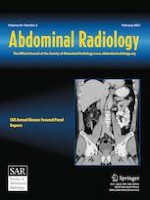Erschienen in:

22.07.2020 | Hollow Organ GI
Utility of texture analysis on T2-weighted MR for differentiating tumor deposits from mesorectal nodes in rectal cancer patients, in a retrospective cohort
verfasst von:
Isha D. Atre, Kulyada Eurboonyanun, Yoshifumi Noda, Anushri Parakh, Aileen O’Shea, Rita Maria Lahoud, Naomi M. Sell, Hiroko Kunitake, Mukesh G. Harisinghani
Erschienen in:
Abdominal Radiology
|
Ausgabe 2/2021
Einloggen, um Zugang zu erhalten
Abstract
Objective
The purpose of the study was to evaluate the utility of MR texture analysis for differentiating tumor deposits from mesorectal nodes in rectal cancer.
Materials and methods
Pretreatment MRI of 40 patients performed between 2006 and 2018 with pathologically proven tumor deposits and/or malignant nodes in the setting of rectal cancer were retrospectively reviewed. In total, 25 tumor deposits (TDs) and 71 positive lymph nodes (LNs) were analyzed for morphological and first-order texture analysis features on T2-weighted axial images. MR morphological features (lesion shape, size, signal heterogeneity, contrast enhancement) were analyzed and agreed in consensus by two experienced radiologists followed by assessment with Fisher’s exact test. Texture analysis of the lesions was performed using TexRAD, a proprietary software algorithm. First-order texture analysis features (mean, standard deviation, skewness, entropy, kurtosis, MPP) were obtained after applying spatial scaling filters (SSF; 0, 2, 3, 4, 5, 6). Univariate analysis was performed with non-parametric Mann–Whitney U test. The results of univariate analysis were reassessed with generalized estimating equations followed by multivariate analysis. Using histopathology as a gold standard, diagnostic accuracy was assessed by obtaining area under the receiver operating curve.
Results
MR morphological parameter, lesion shape was a strong discriminator between TDs and LNs with a p value of 0.02 (AUC: 0.76, 95% CI of 0.66 to 0.84, SE: 0.06) and sensitivity, specificity of 90% and 68%, respectively. Skewness extracted at fine filter (SSF-2) was the only significant texture analysis parameter for distinguishing TDs from LNs with p value of 0.03 (AUC: 0.70, 95% CI of 0.59 to 0.79, SE: 0.06) and sensitivity, specificity of 70% and 72%, respectively. When lesion shape and skewness-2 were combined into a single model, the diagnostic accuracy was improved with AUC of 0.82 (SE: 0.05, 95% CI of 0.72 to 0.88 with p value of < 0.01). This model also showed a high sensitivity of 91% with specificity of 68%.
Conclusion
Lesion shape on MR can be a useful predictor for distinguishing TDs from positive LNs in rectal cancer patients. When interpreted along with MR texture parameter of skewness, accuracy is further improved.











